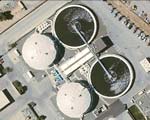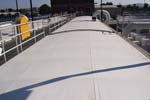
Case Study: Retractable Covers Contain Aeration Basin Off-Gas Odors
- By Jim McMahon
- Mar 16, 2010

Inside the Vallejo aeration basin prior to the new cover installation.
The Vallejo Sanitation & Flood Control District in the San Francisco Bay area has been engaged in a program to scrub off-gas odors from all aspects of its wastewater treatment plant.
Most recently, the wastewater plant has focused on scrubbing off-gas odors from its secondary treatment processes, and specifically its two open aeration basins. To contain these odors, the district opted to use a retractable, structurally supported geomembrane cover system from Geomembrane Technologies Inc. (GTI), which proved effective for the collection of off-gas and provided flexibility and ease-of-access for tank monitoring, maintenance and repairs. GTI designs, engineers, fabricates, installs, and maintains complete odor control systems worldwide.
The Vallejo plant's two secondary process aeration basins were originally built in 1988, and are each 15 feet deep, 15 feet wide and 110 feet long. Every few weeks, the Vallejo operators conduct a visual inspection into the aeration tanks from the top. Once a year they drain the tanks, go down inside to conduct a physical inspection of the blowers and diffusers at the bottom, and hose down the sides of the basins.
For almost 20 years the basins remained uncovered, but as part of the plant's odor control upgrade, the district looked into options of how to cover them. Carollo Engineers, an environmental engineering firm specializing in the planning, design and construction of water and wastewater facilities, was retained by Vallejo to handle the design and construction management for the plant odor control upgrade, and began reviewing different cover options for enclosing the basins.
"We wanted the covers first for odor control, so they needed to be corrosion resistant," says Tim Tekippe, Carollo project manager handling the Vallejo project. "But we also needed the covers to be easy to open and close for access to the tanks for sampling, scheduled maintenance and repairs. We felt structurally supported covers would be the best system for the plant's needs because of the better access they provide over other systems, like floating covers. We first looked at rigid type covers such as aluminum and fiberglass, but both of these proved more labor intensive for operators to gain access to the basins."
Depending on their size, aluminum panels can be heavy, and both aluminum and fiberglass covers being rigid, can be bulky and difficult to maneuver for workers while perched above an open tank. This tricky maneuver requires a fair amount of labor – both to take the aluminum panels off, place the covers aside and later put the covers back on – but also poses a potentially significant safety hazard for the workers.
"Along with our engineering firm, Carollo, we looked at a number of other wastewater plants, and what they were using to cover their aeration tanks," says Barry Pomeroy, director of Operations and Maintenance at the Vallejo Sanitation & Flood Control District. "The aluminum and fiberglass covers we looked at were big plates and seemed hard to handle and remove. Then we went to a water treatment plant in Colorado that was using retractable, structurally supported covers made with a geomembrane fabric. They looked like they would be very easy to remove for maintenance, and watched how easy they were to open and close. We even walked on them while they were in place over the tank, to see how strong and durable they were. Based on that trip, we decided to design these retractable covers into our aeration basins."

The aeration basins with the new retractable covers.
Vallejo's cover system – designed, engineered and built by GTI – consists of a composite sheet of high-strength, UV-protected, coated fabric tensioned across a series of low-profile aluminum arches that span the tank's opening. Intermediate aluminum walkways spanning the tank are used to divide the fabric cover sections into appropriate lengths for easy retractability.
The geomembrane cover fabric is made of a laminated sheet of 40 mil specialty PVC (Ethylene Interpolymer Alloy). It incorporates a highly specialized weave design that provides maximum strength-to-weight ratios. Because this topsheet is exposed to the sun, it is also equipped with advanced UV inhibitors. The material can withstand temperatures to minus 30 degrees F.
Vallejo's covers are gas-tight, operating under negative air pressure. A ventilation system draws air through the tank and underneath the covers, and pulls along with it the off-gas from the aeration process. Off-gas removal piping is connected directly to the cover system and out to a soil filter for odor scrubbing.
Although the membrane covers are gas-tight, they can be quickly detached and easily rolled up along the frame. This gives operators access to inspect and maintain internal components of the basins. Reattaching the membrane covers is quick and easy. Additional hatches in the intermediate aluminum walkways allow access by plant operators without retracting the covers.
"The expected life of these retractable covers is about 15 years," explains Tekippe. "And the cost is very attractive compared to other cover systems. If a cover did have to be replaced it would be easy to change out and could be done in minimal time. These retractable covers are very well-suited for both municipal wastewater and drinking water plants. We have since specified them for use in other public water and wastewater projects."
About the Author
Jim McMahon writes on water and wastewater systems.